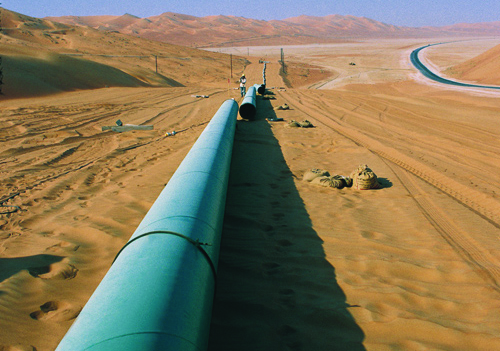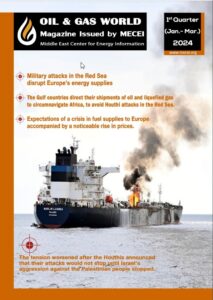- QatarEnergy selects Nakilat to own and operate 25 conventional LNG vessels
- The joint development of the Dorra field between Saudi Arabia and Kuwait is pending the demarcation of the border with Iran
- Minister of Energy reaffirms the UAE’s commitment to adopting clean energy and supporting the Paris Agreement
- The new Hassi Messaoud refinery enjoys the support of the government and President Tebboune
- Increasing electrical interconnection capacities to export electricity beyond borders
- Qatar Energy stops sending liquefied gas tankers through the Red Sea for security reasons
- The inauguration of the Duqm Refinery, the largest joint Gulf project in the refinery sector
- Saudi oil exports are faltering due to Houthi attacks on ships in the Red Sea and Gulf of Aden
- Algeria to host and chair the Gas Exporting Countries Forum summit (February 29 to March 2, 2024)
- Egypt Energy Conference and Exhibition 2024 gives a strong impetus to the global energy dialogue

The Hungarian Energy Policy The natural gas in focus

Global challenges:
The two great paramount challenges of the 21st century are energy security and climate change. The Hungarian energy policy reflects these challenges. The best way avoiding the supply crisis is the very wide diversification, where it is possible. Energy supply emergency measures have the potential to mitigate short‑term issues; but longer term security can only be provided by investment in production, transformation and transport infrastructure.
Careful market design and right incentives liberalized markets are both powerful tools to attract sufficient investment and bolster security of supply. The diversity of supply has also become a watchword of Hungarian energy security policy. There is a need to diversify the fuel mix, the energy sources and the import routes.
Hungary energy policy:
Domestic energy production (from oil, gas, nuclear power, low calorific coal and lignite) meets approximately half of Hungary’s energy requirements. The remaining energy needs are met from oil imports. Domestic oil production has peaked, so when energy consumption begins to raise, dependency on oil imports will also likely rise.
Hungary‘s Primary Energy Supply (1990-2010)
(in millions of metric tons of oil equivalent)
| Fuels | 1990 | 2000 | 2005 | 2010 |
| Coal | 6.12 | 4.01 | 4.63 | 5.38 |
| Oil | 8.52 | 7.16 | 7.52 | 7.75 |
| N. Gas | 8.90 | 10.06 | 10.23 | 10.32 |
| Nuclear | 3.58 | 3.65 | 3.65 | 3.65 |
| Hydro | 0.02 | 0.02 | 0.02 | 0.05 |
| Others* | 0.37 | 0.99 | 1.03 | 1.08 |
| Total | 28.46 | 26.09 | 27.28 | 28.40 |
* includes renewables (other than hydro) and energy from waste
Source: OECD/IEA
Hungarian Energy strategy 2008-2020 that was approved by the Parliament in April 2008 has three main pillars: security of supply, competitiveness and sustainability.
Safety of Supply
In Hungary the total import dependency is about 70%. This is the reason why the security of supply is the one of the most important pillar of Hungarian new energy strategy.
Main priority: diversification of natural gas sources and transit routs. Realistic possibilities: Nabucco, South Stream, new pipeline from LNG terminal in Croatia.
Strategic stockpiling of natural gas in underground storage. From this year 1.2 bcm as strategic reserve based on Law.
New interconnections with neighboring countries: Slovakia, Romania, Croatia, Slovenia.
The natural gas sector plays an absolute eminent role in the energy supply of Hungary as it constitutes 47% in total primary energy supply (TPES) and still growing. The share of the natural gas is one of the highest in the OECD or in the EU, as the import dependency is about 80%, and meanwhile Hungary has other trade partners, all import molecule originates from Russia. In this situation the diversification by sources and by transit routes is an essential task for the Government.
Hungary has some limited possibilities as a landlocked country. These are the well known Nabucco project and the South Stream project. The third option is an LNG terminal at Adriatic seaside.
Import dependency of Hungary:
Hungary had a slight more than 100 million barrels of proven oil reserves. As its production is less than 50 thousand bbl/d of oil, Hungary is therefore heavily dependent on oil imports, mostly from Russia. All activities related to the hydrocarbon industry are carried out by the Hungarian Oil Co. (MOL).
MOL’s refineries produce about 88,500 barrels of oil equivalent per day, and it operates more than 760 gas stations in the CzechRepublic, Hungary, Poland, Romania, Slovakia, Slovenia, and the Ukraine. Other activities include transmission, storage, and wholesale trading of natural gas and related products, and exploration and production in Hungary, Russia, and areas of Central and Eastern Europe.
Within Hungary, apart from MOL, several foreign companies, including Coastal Hungary Ltd, Blue Star, Mobil Erdgas-Erdöl Gmbh and El Paso, participate in hydrocarbon exploration.
The latest Hungary Oil & Gas Report from Business Monitor International (BMI) forecasts that Hungarian oil consumption has fallen from 151,000b/d in 2005 and is expected to reach 163,000b/d by 2010. Domestic production, largely in the hands of former state company MOL, is not expected to recover from the recent decline, with steady slippage leading to higher import volumes (136,000b/d estimated by 2010). Gas demand is forecast to increase to around 15.5bcm (in 2010) implying net gas imports of 13.1bcm by 2010. The government has confirmed its involvement in the South Stream gas pipeline project. The estimated cost of the pipeline is $10bn, with the opening planned for 2013.
Market issues:
In line with the relevant EU directives, Hungary has introduced from 1 July 2009 a new model for the natural gas market. The country abolished the former model’s dual markets (public utility market, competitive market), and now it has only a uniform competitive market, and there is no more price regulation on this market. It is worthy to mention that the full natural gas market opening has started from 1st July 2009.
Sustainability:
– Energy Efficiency Action Plan approved by the Government.
– Renewable Energy Strategy approved by the Government.
– Preparation a new Climate Change Law initiated by the National Sustainable Development Council led by the President of the Hungarian Parliament.
– The Green Investment Scheme in operation with the responsibility of Ministry of Environment and Water. Main target is the panel built housing energy efficient refurbishment.
Reducing the carbon intensity is the essential requisite and condition of the success of Hungary fight against global warming. The increased use of nuclear fits into this picture.
Naturally in parallel with other efforts, Hungary would like to become more energy efficient, to reduce consumption of energy, and to increase energy production from renewable sources. Hungary aims to have 13% of energy from renewable sources by 2020 (from the today’s 4.7%) as help to reduce green-house-gas emissions. To meet with this very ambitious goal, a huge amount of investment and a technology transfer is necessary in Hungary.
Natural gas situation
Hungary has a very important import dependency on natural gas; the domestic production is only 20% of the consumption. The main route of the import gas via Ukraine, beyond this the country has possibility import gas from Austria.
Hungary has one of the best organizations for emergency oil storage. Shortly after, the gas price dispute between Russia and Ukraine in January 2006 brought security of supply into sharp focus for Hungary, and the Hungarian government reacted quickly for the establishment of strategic gas storage. Now Hungary has a relatively big commercial underground storage capacity which is about 4.4 bn m3. Beyond this, in line with the new natural gas stockpiling law, Hungary should have 1.2 bn m3 strategic reserves. This capacity is enough to supply 20 Mm3/day for 45 days.
Because of the one source dependency Hungary is interested in diversification, for this reason it supports the Nabucco pipeline project, South-stream pipeline project and also an interconnection towards a future LNG Terminal at Adriatic Sea. The country has also an eminent and active role in the regional interconnections according to the Economy Recovery Plan of EU and as a core country of transit. The first possible step is the interconnection of Croatian, Serbian, Bosnian and Romanian gas system in the frame of NETS (New European Transmission System). With this regional co-operation the vulnerability of the region drastically decreased, and the diversification approved and there will be a harmonization in the regulation, with an enhanced competition.
Relation with the Middle East:
The Middle East and the Gulf region have affluent markets with huge excess capital that are in the closest proximity to Europe and which are within reach in terms of corporate action in Hungary. Ongoing economic relations with these regions are steadily expanding and play an important role in maintaining Hungary’s trade balance, in addition to contributing to energy supply in the long term.
Hungary’s exports to the region approximately totaled 1.4 billion U.S. dollars compared to imports of just below 50 million dollars. Substantial Hungarian investments have been launched in the region, among them those brokered by Hungarian Oil Company, MOL.









